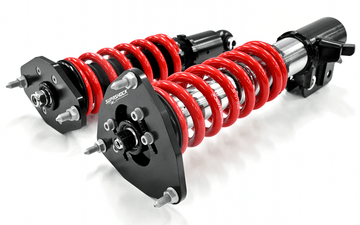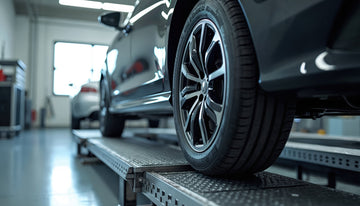Camber plates are specialised components designed to enable precise camber adjustments in a vehicle's suspension system. Acting as adjustable adapters, these plates are typically installed on top of the strut, serving as a connection point between the shock absorber and the vehicle chassis.
By incorporating camber plates into the suspension setup, drivers gain the ability to fine-tune the camber angle, which refers to the vertical tilt of the wheel relative to the road surface. This adjustability allows for optimal customisation and fine-tuning of the vehicle's handling characteristics, as well as tire wear patterns. Camber plates are widely available and compatible with various car models and suspension configurations, offering a versatile solution for achieving desired camber settings.
Benefits of Camber Plates: Improve Handling and Performance with Adjustable Camber!
Camber plates offer several benefits for vehicle owners and enthusiasts who are seeking improved performance and handling characteristics. Some of the key advantages of camber plates include:
Enhanced cornering and stability
By adjusting the camber angle, camber plates enable drivers to optimise the contact patch of the tires with the road surface during cornering. This improved contact patch provides better grip, resulting in enhanced cornering ability and increased stability during aggressive driving manoeuvres.
Customisable handling
Camber plates allow for fine-tuning of the camber angle to suit individual preferences and driving styles. This adjustability enables drivers to tailor the vehicle's handling characteristics, such as understeer or oversteer, to their liking, providing a more personalised and engaging driving experience.
Tire wear optimisation
Incorrect camber angles can cause uneven tire wear, reducing the lifespan of the tires and potentially compromising safety. By using camber plates to dial in the optimal camber settings, tire wear can be more evenly distributed across the tire surface, resulting in improved longevity and cost savings.
Improved performance on track
Camber plates are particularly beneficial for track enthusiasts and competitive racing. By adjusting the camber angle, drivers can maximise the tire's contact patch, enhancing traction and grip during high-speed cornering, ultimately leading to faster lap times and improved overall performance on the track.
Suspension tuning flexibility
Camber plates offer additional flexibility in suspension tuning. They allow for separate adjustment of the camber angle without affecting other suspension parameters such as ride height or spring rates. This versatility enables enthusiasts to fine-tune their suspension setup to achieve the desired balance between comfort and performance.
Camber Plate Adjustments: Fine-Tuning Your Suspension for Maximum Performance and Comfort
If you're unsure or lack experience in making suspension adjustments, it's recommended to consult with a knowledgeable mechanic or suspension specialist. They can provide expert guidance and ensure that the camber adjustments are made accurately and safely.
Here's a guide on how to adjust camber plates:
Gather the necessary tools
You'll need an Allen key of the appropriate size to loosen and tighten the adjusting screws on the camber plates. Make sure you have the correct size Allen key on hand before proceeding.
Understand your goals and research
Before making any adjustments, it's essential to have a clear understanding of the desired handling characteristics you want for your car. Take the time to research and gather information from reputable sources such as automotive forums, professional guides, or expert advice. This will help you make informed decisions when adjusting the camber angle.
Loosen the adjusting screws
Using the Allen key, carefully loosen the four adjusting screws on the camber plate. Loosening these screws will allow you to move the shock absorber in or out to adjust the camber angle.
Make the desired adjustment
Referencing the markers on top of the camber plate, determine the direction and amount of adjustment needed for your specific requirements. Move the shock absorber in or out accordingly to achieve the desired camber angle. It's important to make small, incremental adjustments and evaluate the effects after each change.
Tighten and torque the adjusting screws
Once you have made the necessary adjustment, tighten the adjusting screws securely using the Allen key. It's crucial to follow the manufacturer's recommended torque specifications to ensure proper tightening.
Repeat on the opposite side
Adjusting the camber angle on one side of the vehicle may impact the overall balance and handling. To maintain symmetry, repeat the same adjustment process on the opposite side of the vehicle.
Test and evaluate
After making the adjustments on both sides, it's important to test the vehicle's handling characteristics. Take your car for a test drive and pay attention to how it responds during different driving conditions. Assess whether the adjustments have achieved the desired effect and make further adjustments if necessary.
Make one change at a time
When adjusting any setting that affects handling, including camber, it's advisable to make one change at a time. This approach allows you to evaluate the impact of each adjustment and understand how it influences the vehicle's behaviour. Making multiple changes simultaneously can make it difficult to pinpoint the specific effects of each adjustment.
Maintenance Tips: Keep Your Camber Plates in Top Shape for Optimal Performance
To ensure optimal performance and longevity of your camber plates, proper maintenance is essential. Here are some tips to keep your camber plates in top shape:
Regular Inspections: Periodically inspect your camber plates for any signs of wear, damage, or misalignment. Look for cracks, excessive play, or loose fasteners. Address any issues promptly to prevent further damage.
Lubrication: To keep your camber plates working smoothly, apply lubricant to the moving parts. Follow the manufacturer's guidelines for how often to lubricate and use the right lubricant for your camber plates.
Cleaning: Keep your camber plates clean from dirt, debris, and grime. Regularly remove any buildup that can affect their performance or cause premature wear.
Torque Checks: Verify the tightness of all fasteners and bolts on your camber plates. Over time, vibrations and vehicle operation can cause them to loosen. Periodically check and retighten as necessary, following the recommended torque specifications.
Professional Assistance: If you're unsure about performing maintenance tasks or encounter significant issues, seek the help of a qualified mechanic or technician. They can provide expert advice, conduct thorough inspections, and address any maintenance or repair needs.
By following these maintenance tips, you can keep your camber plates in excellent condition, ensuring optimal performance and enhancing the overall handling and stability of your vehicle.





